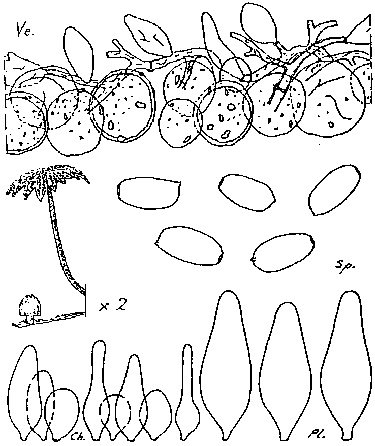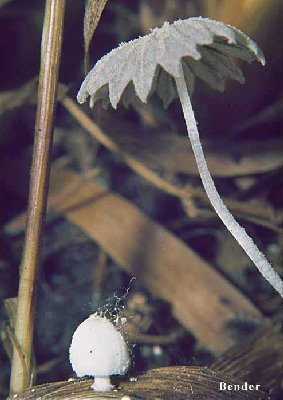Macroscopic features |
Closed pileus globose, subglobose to ellipsoid or oval, up to 8 mm high and 4 mm wide, at first white to grey or pale brownish with powdery white veil beneath a cortina-like covering; expanded pileus 5-12 mm, then margin conspicuously split in the shape of a star and centre of pileus pale grey-brown; lamellae free, somewhat distant, white to blackish; stipe 20-50 x 0.5-1.2 mm, hollow, equal or attenuate upwards, when young covered with white velar flocks, at base more dense and forming a volva-like ring zone; smell absent. |
Microscopic features |
Spores (8-)9-11.5 x 6-7(-7.5) µm, in side view somewhat cylindrical, oval or ellipsoid in frontal view, with central germ pore, dark red-brown; basidia 4-spored; cheilocystidia 18-45 x 8-13 µm, variable in shape: (sub)globose, ellipsoid, elongate-ellipsoid, utriform or (mostly) lageniform; pleurocystidia up to 60 µm in length, ellipsoid or utriform; pileipellis made up of ventricose, ellipsoid and subglobose elements covered by about 7 µm wide hyphae consisting of oblong-ventricose elements and these passing upwards into thin-walled colourless to slightly yellowish, smooth to granular, up to 45(-55) µm wide, globose velar elements, mixed with elongate elements; clamp-connections present. |
Habitat & distribution |
Gregarious. On dying grass ( stems of Festuca). Known only from the type locality. |
Remarks |
The description and illustration given here are based on the original description by Enderle & Bender (l.c.) |

[Copyright © by H. Bender]

[Copyright © by Hans Bender jbe8995374@aol.com]